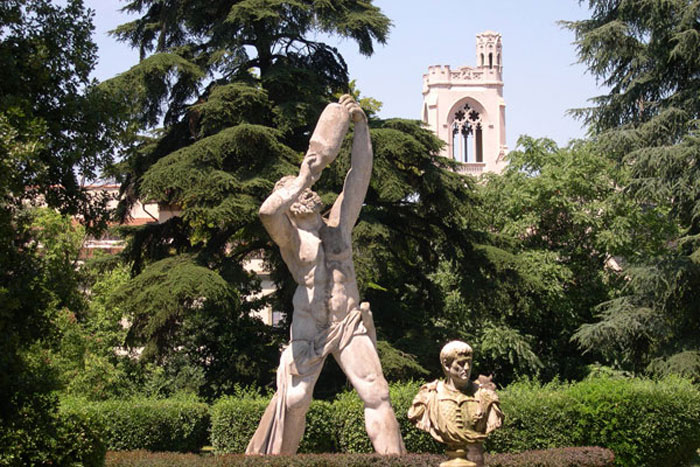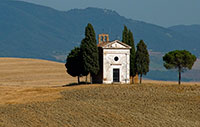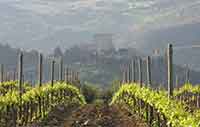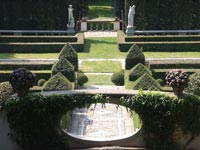| |
|
Oricellari Gardens
Address: Via degli Orti Oricellari, 9 , 50123 Firenze

Art in Tuscany | Florence | Santa Maria Novella
Walking in Tuscany | Florence | Quarter of Santa Maria Novella
You can start this tour from Santa Maria Novella, the main railway station in Florence built in 1933/35 by Michelucci Group. Take via degli Avelli, in front of the train station and arrive in Piazza Santa Maria Novella, the church is one of the most famous and beautiful churches in Florence, rich of masterpieces. Admire the square and the façade by Leon Battista Alberti. You need the whole morning to visit the church and the Cappellone degli Spagnoli, the green cloister (Description in “Churches” section) – You can have a free tour of the church. Coming out from the church, go to the left in via delle Belle Donne there is a little square with a column: The Croce al Trebbio (1338) with the symbols of the Evangelists.

[1] Bianca Cappello (1548 – 17 October 1587) was an Italian noblewoman who was the mistress, and afterward the second wife, of Francesco I de' Medici, Grand Duke of Tuscany. Her husband officially made her his consort.
She was born in Venice, in 1548, the daughter of Bartolomeo Cappello and Pellegrina Morosini, a member of one of the richest and noblest Venetian families, and was noted for her great beauty.[1]
At the age of fifteen she fell in love with Pietro Bonaventuri, a young Florentine clerk in the firm of Salviati, and on 28 November 1563 escaped with him to Florence, where they were married. In 1564 she had a daughter named Virginia, or, according to other sources, Pellegrina. The Venetian government made every effort to have Bianca arrested and brought back but the Grand Duke Cosimo I intervened in her favour and she was left unmolested.[2]
However, she did not get on well with her husband's family, who were very poor and made her do menial work, until at last her beauty attracted Grand Prince Francesco, son and heir apparent of the grand duke.[3]
Although already married to Joanna of Austria, he seduced Bianca and gave her jewels, money and other presents. Bianca's husband was given court employment, and consoled himself with other ladies. In 1572 he was murdered in the streets of Florence in consequence of some amorous intrigue, though it is possible that Bianca and Francesco were involved.
|
Bianca Cappello (1548 – 17 October 1587) was an Italian noblewoman who was the mistress, and afterward the second wife, of Francesco I de' Medici, Grand Duke of Tuscany. Her husband officially made her his consort.
She was born in Venice, in 1548, the daughter of Bartolomeo Cappello and Pellegrina Morosini, a member of one of the richest and noblest Venetian families, and was noted for her great beauty.[1]
At the age of fifteen she fell in love with Pietro Bonaventuri, a young Florentine clerk in the firm of Salviati, and on 28 November 1563 escaped with him to Florence, where they were married. In 1564 she had a daughter named Virginia, or, according to other sources, Pellegrina. The Venetian government made every effort to have Bianca arrested and brought back but the Grand Duke Cosimo I intervened in her favour and she was left unmolested.[2]
However, she did not get on well with her husband's family, who were very poor and made her do menial work, until at last her beauty attracted Grand Prince Francesco, son and heir apparent of the grand duke.[3]
Although already married to Joanna of Austria, he seduced Bianca and gave her jewels, money and other presents. Bianca's husband was given court employment, and consoled himself with other ladies. In 1572 he was murdered in the streets of Florence in consequence of some amorous intrigue, though it is possible that Bianca and Francesco were involved. On the death of Cosimo in 1574 Francesco succeeded to the grand duchy; he now installed Bianca in a palace (now known as Palazzo di Bianca Cappello) close to his own and outraged his wife by flaunting his mistress before her. As Giovanna had borne Francesco only one son, Filippo (20 May 1577 – 29 March 1582) who died as a juvenile, and six daughters, of whom, only two lived to adulthood, Bianca was very anxious to present him with an heir, for otherwise her position would remain very insecure. In 1576 she gave birth to Don Antonio de' Medici (d. 1621), but he was not openly acknowledged as Francesco's heir until after Joanna's death, when the boy was about three years old.[4]
Marriage
In 1578 Giovanna died; a few months later Francesco secretly married Bianca, and on 10 June 1579, the marriage was publicly announced. Two days later, on the 12 June, Bianca was crowned the Grand Duchess of Tuscany at the Palazzo Vecchio in Florence. The Venetian government now put aside its resentment and was officially represented at the magnificent wedding festivities, for it saw in Bianca Cappello an instrument for cementing good relations with Tuscany. But the long expected heir failed to come, and Bianca realized that if her husband were to die before her she was lost, for his family, especially his brother Cardinal Ferdinand, hated her bitterly, as an adventuress and interloper.[5]
In October 1587, at the Villa Medici in Poggio a Caiano, Francesco and Bianca died on the same day, possibly poisoned, or as some historians believe, from malarial fever. In 2006, forensic and toxicology experts at the University of Florence reported evidence of arsenic poisoning in a study published in the British Medical Journal,[6] but in 2010 evidence of the parasite Plasmodium falciparum, which causes malaria, was found in Francesco's remains.[7]
Montaigne, the French writer, described Bianca in diplomatic terms:" According to the Italians [she] is beautiful. She has an agreeable and imposing face, and large breasts, the way they like them here…”
[1] Lytton, Lytton, Rosina Wheeler Bulwer (2010). Bianca Cappello: An historical romance. Nabu Press. pp. 13–14. ISBN 978-1144883667.
[2] Sizeranne, Robert de La (1969). Celebrities of the Italian Renaissance in Florence and in the Louvre. Bianca capello in the pitti palace. pp. 122–124. ISBN 978-0836913026.
[3] Sizeranne, Robert de La (1969). Celebrities of the Italian Renaissance in Florence and in the Louvre. Bianca capello in the pitti palace. pp. 125–126. ISBN 978-0836913026.
[4] Roberto Cantagalli, “Bianca Cappello e una leggenda da sfatare; La questione del figlio supposto,” Nuova rivista storica 44 (1965): 636–652; Jacqueline Marie Musacchio, “Objects and Identity: Antonio de' Medici and the Casino at San Marco in Florence,” in The Renaissance World, ed. John Jeffries Martin (New York: Routledge, 2007), 481–500.
[5] Sizeranne, Robert de La (1969). Celebrities of the Italian Renaissance in Florence and in the Louvre. Bianca capello in the pitti palace. pp. 129–130. ISBN 978-0836913026.
[6] Francesco Mari; Aldo Polettini, Donatella Lippi, Elisabetta Bertol (2006). "The mysterious death of Francesco I de' Medici and Bianca Cappello: an arsenic murder?". BMJ 333 (June 23–30, 2006): 1299–1301. doi:10.1136/bmj.38996.682234.AE. PMC 1761188. PMID 17185715.
[7] Lorenzi, Rossella (14 July 2010). "Medici family cold case finally solved". Discovery.com. Retrieved 16 July 2012.
|
|
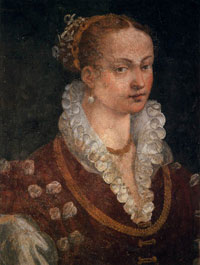
Alessandro allori, Portrait of Bianca Cappello, c. 1580, fresco, Galleria degli Uffizi, Firenze
Grand Duke Francesco I de' Medici was a man of profound and obsessive passions. The Uffizi galleries, which he established, were one, Bianca Cappello (1548-1587), his mistress, and afterwards, the second wife, was the other.
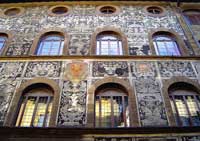
16th century sgraffito on
Bianca Cappello's house
|
| [2] Palazzo Venturi Ginori |
|
|
Bibliography
Pozzana, Mariachiara, Gardens of Florence and Tuscany (Giunti Editore, 2001)
Pratolino, Villa Demidoff (Alinari, 1990)
Steegman, Mary G., Bianca Capello (Norman Remington and Company, 1913).
Vannucci, Marcello. Le Donne di Casa Medici (Newton and Compton, 1999)
James Chater, "Bianca Cappello and Music", in Renaissance Studies in Honor of Craig Hugh Smyth (Florence, 1985), vol. i, 569–79
Samuele Romanin, Lezioni di storia Veneta, vol. ii (Florence, 1875)
G. E. Saltini, Tragedie Medicee domestiche (Florence, 1898)
Saltini, Della morte di Francesco de' Medici e di Bianca Cappello (Florence, 1863)
Elizabeth Clementine Stedman, Bianca Capello, A Tragedy (1873)
Rosina Wheeler Bulwer-Lytton Lytton (2010) Bianca Cappello: An Historical Romance Nabu Press ISBN 978-1144883667
|
This article incorporates material from the Wikipedia article Bianca Cappello published under the GNU Free Documentation License.
This article also incorporates text from a publication now in the public domain: Chisholm, Hugh, ed. (1911). Encyclopædia Britannica (11th ed.). Cambridge University Press.
|

Located on the outskirts of Castiglioncello Bandini, in a hilly and unspoilt land, Podere Santa Pia is one of the best places to slow traveling in Tuscany. This formal cloister offers the quiet tranquility of a private retreat, with numerous attractions, beautiful nature reserves and unspoilt beautiful beaches within easy reach. The most interesting artistic, historical and cultural sites of southern Tuscany are nearby, and are awaiting your discovery.
Farmhouses in Tuscany | Podere Santa Pia |
| |
|
|
|
|
|
|
|
|
|
|
Podere Santa Pia |
|
Podere Santa Pia, view from the garden
on the valley below
|
|
Florence, Duomo |
| |
|
|
|
|
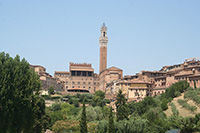
|
|
|
|
|
|
|
San Quirico d'Orcia, Capella Vialeta |
|
Podere Santa Pia, famous wines in southern Tuscany |
| |
|
|
|
|
 |
|
|
Choosing one of the Florence walking tours you'll be able to visit the world-famous museums of the Uffizi and Accademia Galleries, discovering the main historical and artistic treasures of the city.
The tours focus on Florence's major sights and attractions, including the Duomo, the Ponte Vecchio and the city's famous churches and Renaissance palaces.
Novelist Henry James called Florence a “rounded pearl of cities -- cheerful, compact, complete -- full of a delicious mixture of beauty and convenience.” The best way to experience the Italian city’s artistry, history and joy of life is by walking the same paths that the Medicis, Michelangelo and James once used.
1 | A Walk Around the Uffizi Gallery
2 | Quarter Duomo and Signoria Square
3 | Around Piazza della Repubblica
4 | Santa Maria Novella
5 | San Niccolo Neighbourhood in Oltrarno
6 | Walking in the Bargello Neighbourhood
7 | From Fiesole to Settignano
|
|
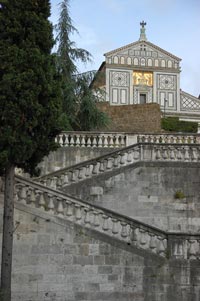
San Miniato al Monte
|
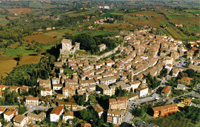
|
|
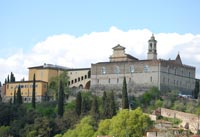 |
|
|
Sarteano |
|
Certosa del Galluzzo (Firenze) |
|
Villa I Tatti
|
|
|
|
